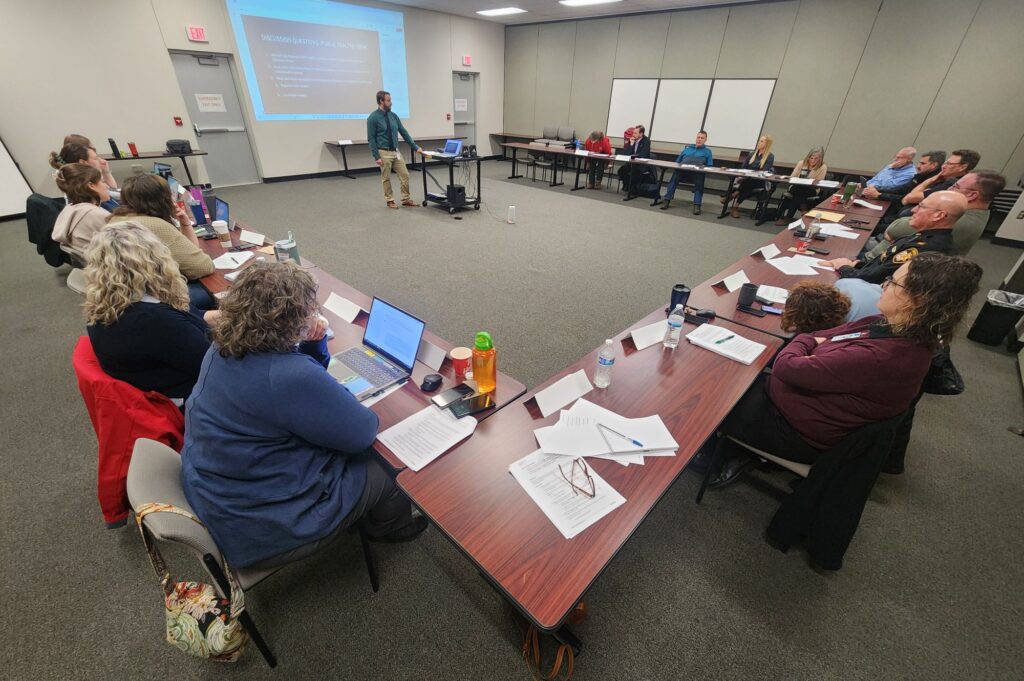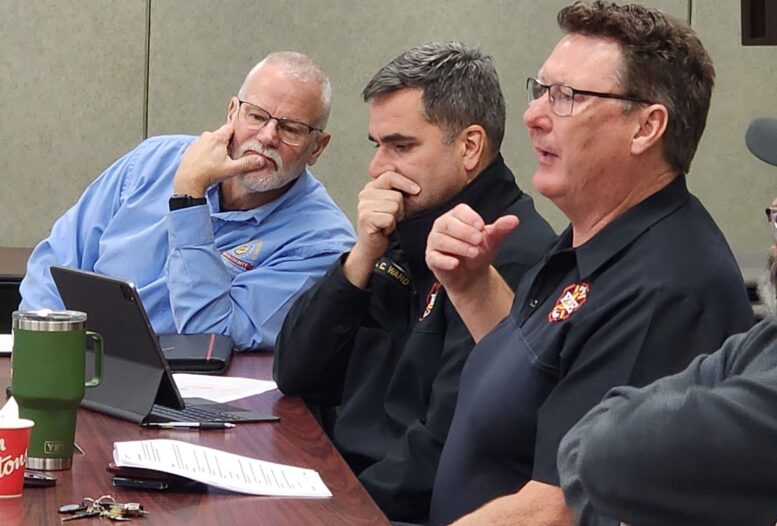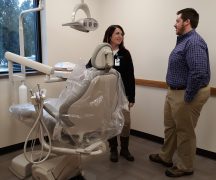By JAN McLAUGHLIN
BG Independent News
This is a drill. This is only a drill.
The choreographed catastrophe scenario began like clockwork last month as local emergency responders gathered around tables waiting for the “disaster” to occur.
At 11:30 a.m., a tanker truck hauling hydrochloric acid collided with a semi-trailer truck on East Wooster Street and South College Drive in Bowling Green.
“Essentially, right in the middle of the city,” said Wood County Epidemiology Director Tyler Briggs as he monitored the local response which came together over four hours.
The force of the impact caused the tanker to overturn and breach its container, resulting in a significant leak of the hazardous cargo. Bystanders and motorists in the vicinity reported a loud explosion followed by a white-yellow vapor cloud emanating from the wreckage. The acrid odor of the vapor irritated throats and eyes, prompting a wave of panicked calls to 911. A light west breeze carried the vapor cloud, raising concerns about the potential for a wider contamination zone.
It didn’t take long before 911 was overwhelmed with calls reporting the accident. First responders arrived on the scene to find the leaking tanker and overturned semi-trailer. Evacuation orders were issued for the immediate vicinity of the accident due to the vapor cloud emanating from the leak.
Residents in the surrounding area began reporting skin irritations, burning eyes, and respiratory discomfort consistent with hydrochloric acid exposure. The number of people exposed was estimated to be in the hundreds, exceeding the local hospital’s capacity to manage a surge in patients.
Within minutes, the first people to spring in action (figuratively) were those accustomed to responding to crashes and chemical spills. Bowling Green Fire Division personnel and Wood County Emergency Management Agency took command.
First things first, BGFD Captain Lucas Ward advised. The problem must be identified and an initial isolation zone identified. BG Police Division was called in to help with evacuations, which began in-person then continued with mass texts or emails.
The fire division and EMA debated where to establish a mass decontamination area for people affected. Time is the enemy, with responders given minutes to make decisions.
“Wood County Hospital will not have the resources to handle this,” BG Fire Chief Bill Moorman said. So hospitals around the region were alerted to the potential for a surge of patients.
While the Bowling Green State University Field House, with its showers that could be used for decontamination, would be great – it sits in the direction of the chemical plume.
“Wherever you put these people it becomes a contaminated vehicle and a contaminated building,” Moorman said.

People around the table toss out other considerations. The hospital should be prepared for potential contamination from people walking into the emergency department. Those on BGSU campus should shelter in place or evacuate – but which? The sheriff’s office should block off the Interstate 75 exit to the city to prevent more traffic from piling up. And what about pets? Are there decontamination provisions for animals?
Decisions must be made on the best way to keep students and staff safe at Crim Elementary School, located just a couple blocks from the crash.
“We are trying to understand the extent of the impact,” Wood County Health Commissioner Ben Robison said.
Calls come into the local health department and local hospitals from those who were at the accident and are complaining of upper respiratory difficulty, burning eyes, runny noses, and difficulty with vision.
Rumors of the event have spread widely. As a result, dozens of “worried well” in neighborhoods adjacent to the crash were arriving at local area hospitals.
Moorman suggested a reunification site be established out of the contamination risk zone.
“There will be 18,000 parents out there wanting to rescue their children,” he said of worried parents of BGSU students.
Emergency responders talked about the need to communicate clearly with the public.
“Get that message – a unified message,” Moorman said.
And they warn to be prepared for misinformation to spread as fast as the chemical plume.
“Information is going to be really messy,” Robison said.
Health department staff talked about possibly monitoring social media to find out what rumors are gaining strength. And staff there offered to set up a hotline for questions from the public.
“We know how to do it, and can get it up pretty easily,” said Beth Peery, director of education and engagement at the Wood County Health Department.
To get the best information on hydrochloric acid, Wood County EMA Director Jeff Klein suggested contacting the local manufacturer where the acid was being delivered, or the company transporting the hazardous material, which is responsible for its safe delivery.
A clean up company will respond to the scene and safely dispose of any contaminated material, Klein said.
The Ohio EPA emergency responder for this region said liquid from the spill going down into the storm sewer could create a source of contamination at every catch basin it reaches.
But since Bowling Green is on a public water system, the chemicals can not reach the city water, said the EPA official and Northwestern Water and Sewer District staff.
However, because of transmission through the air, residences and businesses in the area may have to turn their HVAC systems off for an unknown duration – which would not be popular during very cold or very hot weather, Robison said.
If people are unable to return to their homes for long periods, emergency responders must be prepared for unhappy residents.
“There will be angst, a lot of frustration directed at the response community,” Robison said.
The Wood County Health Department has groups of volunteers it can tap if needed – people already trained for the Medical Reserve Corp or Covid response. The American Red Cross also offered its volunteers and emergency resources.
The issues will likely continue after the initial crisis is over. The fire division will need its ambulances and fire gear decontaminated as quickly as possible. Other emergencies don’t come to a halt during a major response.
And further down the road, it’s possible there will be people suffering from mental health problems due to the crisis. And surveillance of health issues may continue for years.
The purpose of the emergency exercise was to focus on testing and improving the collective response to a large-scale chemical incident in each of the counties participating. Key stakeholders from first responders, public health, emergency management, healthcare, and other relevant agencies to discuss response strategies, identify gaps, and enhance regional coordination.
The key planner of the exercise, William Bryan-Bey, emphasized the need for emergency responders to learn the potential public health impacts of chemical releases, to help strengthen the community’s resilience and readiness.
Eighteen counties in the Northwest Ohio region participated in the tabletop exercise focused on simulating and evaluating a coordinated response to a chemical surge incident.
Participating in the Wood County exercise were representatives from Bowling Green Fire Division, Wood County Emergency Management Agency, Wood County Health Department, Bowling Green City Schools, Northwestern Water and Sewer District, Wood County Sheriff’s Office, Ohio EPA, and the American Red Cross. In addition, Wood County Hospital was involved remotely.
“I was very pleased with the direction of the exercise and the level of engagement displayed by all participants,” said Bryan-Bey, Northwest Ohio Regional Public Health coordinator and emergency response coordinator for Wood County Health Department.
“The exercise promoted meaningful collaboration and discussion. Positive feedback was received regarding the facilitation, which ensured a smooth and productive flow and the active and thoughtful participation of the diverse agencies involved,” Bryan-Bey said.
The exercise participants identified the following strengths:
- Communication pathways are well established within the region.
- A pattern of cooperation already exists among supporting agencies in Wood County and in the region.
- Partners across the region have a clear understanding of when and how they should contact the regional healthcare coordinator and public health coordinator should an incident occur.
- Partners across the region demonstrated a clear understanding of what types of resources they should provide should a nearby county deal with an event of this type.
- The region collaborated well and was engaged in the exercise.
The exercise participants identified the following challenge: In the case of a regional event, resource-sharing can be challenging, as each locality will need to prioritize its own resources to address immediate needs.





